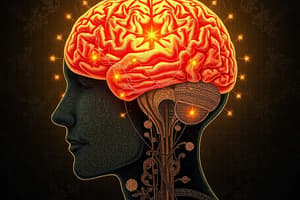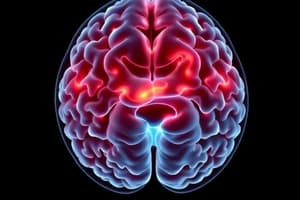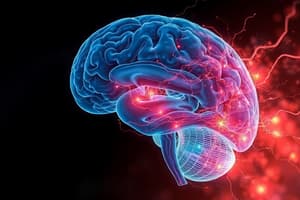Podcast
Questions and Answers
What primarily causes a thrombotic ischemic stroke?
What primarily causes a thrombotic ischemic stroke?
- A sudden rupture of a blood vessel
- An embolism that travels to the brain
- Temporary disturbance in cerebral blood flow due to hypoxia
- A thrombus blocking blood flow due to chronic atherosclerosis (correct)
Which statement accurately describes a hemorrhagic stroke?
Which statement accurately describes a hemorrhagic stroke?
- It is caused by an embolism that blocks arteries in the brain
- It results in generalized seizures that cause loss of consciousness
- It involves a sudden rupture of cerebral blood vessels resulting in increased intracranial pressure (correct)
- It leads to temporary ischemia and resolves before brain damage
What characterizes an absence seizure?
What characterizes an absence seizure?
- It causes significant physical convulsions
- It involves prolonged seizure activity without recovery
- It leads to a brief disturbance in consciousness with a blank stare (correct)
- It typically results in paralysis on one side of the body
What defines status epilepticus?
What defines status epilepticus?
What is a common consequence of a stroke that affects the left side of the brain?
What is a common consequence of a stroke that affects the left side of the brain?
What is the main cause of acute cholecystitis?
What is the main cause of acute cholecystitis?
Which statement best describes the effects of liver failure on iron metabolism?
Which statement best describes the effects of liver failure on iron metabolism?
Which type of hernia refers to a portion of an organ that cannot be reduced back into place?
Which type of hernia refers to a portion of an organ that cannot be reduced back into place?
What is a common consequence of gallstones affecting the bile duct?
What is a common consequence of gallstones affecting the bile duct?
What primarily causes the inflammation seen in acute pancreatitis?
What primarily causes the inflammation seen in acute pancreatitis?
What is a primary cause of peptic ulcers?
What is a primary cause of peptic ulcers?
What is a major complication associated with gastroenteritis?
What is a major complication associated with gastroenteritis?
Which of the following correctly describes diverticulitis?
Which of the following correctly describes diverticulitis?
What characterizes inflammatory bowel disease (IBD)?
What characterizes inflammatory bowel disease (IBD)?
Which condition is characterized by recurrent inflammation affecting all layers of the intestinal wall?
Which condition is characterized by recurrent inflammation affecting all layers of the intestinal wall?
What is a potential outcome of untreated appendicitis?
What is a potential outcome of untreated appendicitis?
What condition involves the presence of pouches in the colon without inflammation?
What condition involves the presence of pouches in the colon without inflammation?
Which statement regarding bowel obstruction is true?
Which statement regarding bowel obstruction is true?
What is acute respiratory failure primarily characterized by?
What is acute respiratory failure primarily characterized by?
Which type of respiratory failure occurs when there is a failure in the gas exchange function?
Which type of respiratory failure occurs when there is a failure in the gas exchange function?
What does ventilation-perfusion mismatch refer to?
What does ventilation-perfusion mismatch refer to?
What condition can result from impaired diffusion during gas exchange?
What condition can result from impaired diffusion during gas exchange?
Which of the following is NOT a common cause of respiratory acidosis?
Which of the following is NOT a common cause of respiratory acidosis?
What type of spinal cord injury is characterized by the impairment or loss of motor and/or sensory function in the cervical spinal cord?
What type of spinal cord injury is characterized by the impairment or loss of motor and/or sensory function in the cervical spinal cord?
What characterizes Chronic Obstructive Pulmonary Disease (COPD)?
What characterizes Chronic Obstructive Pulmonary Disease (COPD)?
Which condition is specifically marked by airway remodeling due to chronic inflammation?
Which condition is specifically marked by airway remodeling due to chronic inflammation?
Which syndrome is predominantly marked by motor impairment in the arms compared to the legs?
Which syndrome is predominantly marked by motor impairment in the arms compared to the legs?
Which condition occurs as a response to noxious stimuli below the level of the original spinal cord injury?
Which condition occurs as a response to noxious stimuli below the level of the original spinal cord injury?
Which of the following best describes bronchiectasis?
Which of the following best describes bronchiectasis?
What is a significant characteristic of Brown-Sequard syndrome?
What is a significant characteristic of Brown-Sequard syndrome?
What potential risks are associated with unresolved autonomic dysreflexia?
What potential risks are associated with unresolved autonomic dysreflexia?
What type of spinal injury is most likely to occur due to hyperflexion or hyperextension of the neck?
What type of spinal injury is most likely to occur due to hyperflexion or hyperextension of the neck?
Which injury is likely due to an infarction of the anterior spinal artery?
Which injury is likely due to an infarction of the anterior spinal artery?
What muscle condition is associated with torticollis?
What muscle condition is associated with torticollis?
Flashcards are hidden until you start studying
Study Notes
Transient Ischemic Attack (TIA)
- Temporary disruption of blood flow to the brain caused by a clot.
- Leads to ischemia and hypoxia, but resolves before infarction occurs.
Stroke
- Sudden impairment of cerebral circulation causing acute neurological deficit.
- Leads to injury or death of brain tissue.
- Right Side Brain Damage: Left sided paralysis, vision problems, quick and inquisitive behavior, memory loss.
- Left Side Brain Damage: Right sided paralysis, speech/language problems, slow and cautious behavior, memory loss.
Ischemic Stroke
- Thrombotic: A thrombus blocks blood flow to the brain, often due to atherosclerosis or vessel narrowing.
- Embolic: An embolism breaks away and lodges in a brain artery, blocking blood flow.
Hemorrhagic Stroke
- Most fatal type of stroke, caused by a ruptured cerebral blood vessel.
- Can be intracerebral or subarachnoid, leading to swelling and brain tissue compression.
- Rapidly progresses to coma and death.
Seizures
- Temporary abnormal behavior due to electrical discharge in the brain.
Status Epilepticus
- Seizures that do not stop spontaneously or occur in succession without recovery.
Postictal State
- Altered level of consciousness following a seizure, typically lasting less than 1 hour.
Generalized Seizures
- Occurs simultaneously in both hemispheres of the brain.
Absence Seizure
- Non-convulsive seizure, typically occurring in children.
- Characterized by a blank stare, motionless and unresponsive state.
- Usually lasts a few seconds and resumes normal activity immediately.
Acute Respiratory Failure
- Failure of the respiratory system in one or both gas exchange functions (oxygenation or CO2 elimination).
- Can be due to heart failure, lung failure, or both.
Hypoxemic Respiratory Failure
- Failure of gas exchange function.
Hypercapnic/Hypoxemic Respiratory Failure
- Ventilatory failure.
Ventilation-Perfusion Mismatch
- Inability to match air flow (ventilation) with blood flow (perfusion) in the lungs.
- Leads to CO2 retention.
Impaired Diffusion
- Impaired gas exchange between alveolar air and pulmonary blood, often due to increased diffusion distance or decreased permeability of respiratory membranes.
Pulmonary Embolism
- A blood borne substance lodges in a pulmonary artery branch, obstructing blood flow.
- Can lead to obstructive shock.
Respiratory Acidosis
- Occurs when ventilation is impaired, leading to increased CO2 levels in the blood.
- Often associated with decreased respiratory drive, lung disease, or chest wall/respiratory muscle disorders.
Asthma
- Overreaction to various stimuli, causing recurrent episodes of wheezing, breathlessness, coughing, and chest tightness.
- Associated with variable airflow obstruction and chronic inflammation leading to airway remodeling.
COPD (Chronic Obstructive Pulmonary Disease)
- Chronic and recurrent obstruction of pulmonary airways.
- Usually progressive and accompanied by inflammatory responses to noxious particles and gases.
- Leading cause of morbidity and mortality worldwide, often caused by smoking, asthma, and hyper-responsiveness.
Bronchiectasis
- Uncommon form of COPD characterized by permanently dilated bronchi and bronchioles.
- Caused by chronic infection and inflammation, leading to destruction of muscle and elastic tissue.
Peptic Ulcer
- Caused by excess HCl, pepsin secretion, or weakened mucosal wall.
- Ulcer can erode blood vessel wall leading to bacterial peritonitis and GI tract obstruction.
Gastroenteritis
- Acute illness manifested by diarrhea and vomiting.
- Can lead to fluid shifts, dehydration, shock, and death.
IBS (Irritable Bowel Syndrome)
- GI disorder with various symptoms: abdominal pain, altered bowel function, bloating etc.
- Often associated with psychosocial abnormalities, sensory, and CNS processing issues.
Inflammatory Bowel Disease (IBD)
- Inflammation of the bowel with systemic manifestations.
Crohn's Disease
- Slow progressive recurrent inflammation of sections of the GI tract.
- Affects all layers of the intestinal wall, causing fibrosis and narrowing of the lumen.
Ulcerative Colitis
- Non-specific continuous inflammatory condition of the colon.
- Causes edema and weakening of the colon wall, leading to ulceration.
Diverticular Disease
- Can cause fatal obstruction, hemorrhage, or infection.
- Diverticulum: Herniating of mucosa through the muscle layer of the colon wall.
- Diverticula: Multiple pouches.
- Diverticulosis: Presence of diverticula without inflammation.
- Diverticulitis: Inflammation or perforation of the pouches.
Appendicitis
- Obstruction of the appendix, usually by a calcified stone or gallstone.
- Leads to inflammation, increased mucus production, pressure in the lumen, and occlusion of small blood vessels.
- The appendix becomes ischemic and bacteria leak out, potentially leading to rupture and peritonitis.
Bowel/Intestinal Obstruction
- Lack of intestinal content movement.
- More common in the small intestine due to its smaller size.
- Can be partial or complete, caused by mechanical or functional obstruction.
Peritonitis
- Acute or chronic inflammation of the peritoneum.
- Develops secondary to chemical or bacterial invasion.
- Inflammation spreads quickly, triggering an inflammatory response with vasodilation and increased capillary permeability.
Hernia
- Portion of an internal organ protrudes through the wall of the cavity surrounding it.
- Can be reduced (manipulated back into place), incarcerated (stuck), or strangulated (blood supply cut off).
Liver Failure
- Can lead to organ failure, stopping the liver from producing bile and storing glucose.
- Anemia can occur due to impaired iron metabolism.
Gallstones
- Abnormalities in bile composition, stasis of bile, and inflammation of the gallbladder can lead to stone formation.
- Stones are composed of cholesterol and bilirubin.
- Small stones cause indigestion and biliary colic.
- Larger stones cause obstruction and jaundice.
Cholecystitis
- Inflammation of the gallbladder.
- Acute Cholecystitis: Diffuse inflammation secondary to outlet obstruction.
- Chronic Cholecystitis: Repeated acute or chronic irritation of the gallbladder with gallstones.
Pancreatitis
- Inflammation of the pancreas.
- Acute Pancreatitis: Auto-digestion of pancreatic tissue by prematurely activated pancreatic enzymes, often caused by alcohol abuse and gallstones.
- Chronic Pancreatitis: Persistent inflammation, leading to irreversible changes in the pancreas structure and function.
Abdominal Hemorrhage
- Can be caused by trauma, aneurysm, etc.
- Symptoms include diarrhea, melena, hematemesis, and coffee-ground vomit.
Spinal Cord Injuries
- Can be complete, partial, or compression injuries.
- Complete: No motor or sensory function preserved in the sacral segments.
- Incomplete: Some residual motor or sensory function below the level of injury.
- Incomplete lesions include central cord, anterior cord, or Brown-Sequard syndromes.
C1-C7 Spinal Cord Injuries
- Most common hyperflexion or hyperextension injuries to the neck, and compression fracture.
- Controls vital functions like breathing.
- Dislocation of any vertebra in this region can crush or compress the spinal cord, compromising blood supply.
Tetraplegia
- Impairment or loss of motor or sensory function due to damage to neural structures in the cervical spinal cord.
Paraplegia
- Impairment or loss of motor or sensory function in the thoracic, lumbar, or sacral segments of the spinal cord.
Central Cord Syndrome
- Injury predominantly in the central gray or white matter of the spinal cord.
- More likely to affect the arms than the legs.
Anterior Cord Syndrome
- Usually due to anterior spinal artery infarction.
- Can be spontaneous or secondary to trauma.
Brown-Sequard Syndrome
- One-sided spinal cord damage, typically due to traumatic injury.
Autonomic Dysreflexia
- Occurs in patients with resolved spinal shock and a return of autonomic reflexes.
- At risk for patients with C1-T6 injuries.
- Triggered by noxious stimuli below the level of injury.
- Causes a massive sympathetic response, uncontrolled by the brain.
- Requires immediate resolution as it can increase the risk of stroke, heart failure, unconsciousness, retinal hemorrhage, pulmonary edema, and MI.
Torticollis
- External deformation where the neck is twisted to one side with the chin protruding to the opposite side.
- Caused by contracture of the sternocleidomastoid muscle, associated with muscle spasms causing lateral flexion of the cervical spine musculature.
Studying That Suits You
Use AI to generate personalized quizzes and flashcards to suit your learning preferences.




